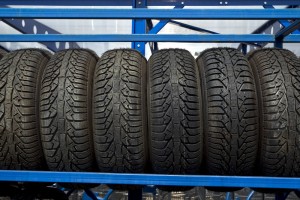When to Replace your Tires
 Ever thought the time you need to replace your worn down car tires? The efficiency of your car tires is crucial to the safety, and efficiency of your vehicle; the N.H.T.S.A. estimates that about 400 fatalities annually may have been resulting from tire failures. A great deal of tires are built to provide similar capabilities throughout their lives. But nevertheless, in some unspecified time in the future they initiate to lose efficiency in terms of their traction and braking capability. Here are a few tips that should help you decide if it is time to start shopping for a new set of tires and prevent paying more than what you need to.
Ever thought the time you need to replace your worn down car tires? The efficiency of your car tires is crucial to the safety, and efficiency of your vehicle; the N.H.T.S.A. estimates that about 400 fatalities annually may have been resulting from tire failures. A great deal of tires are built to provide similar capabilities throughout their lives. But nevertheless, in some unspecified time in the future they initiate to lose efficiency in terms of their traction and braking capability. Here are a few tips that should help you decide if it is time to start shopping for a new set of tires and prevent paying more than what you need to.
Steps:
1)Understand that the most important function of tread on a tire is to divert water from beneath the tire to further improve traction and avoid hydroplaning on wet roads. Tires become weak when they’re damaged, and once the tread is down to 1/16th of an inch (1.6mm), the tire is no longer risk-free.
2)Consider the tread pattern. All tires sold in the United States and other countries have what are called \”tread wear bars\”. These are generally small bridges that form between your treads. Focus on the tread pattern and you’ll see the beginnings of these bars begin to form between the treads, or running across the tires. As the tires wear, these bars will become flush (level or even) with the tire’s tread. At this point, it’s about time to replace the tires.
3)Check the tread by using the \”penny test.\” Have a penny, and place it upside down with Lincoln facing you in the center of the tread (at the thickest part of the tire).
-If you can see the very top of Lincoln’s head or the copper above it, replace the tires straightaway.
-If Lincoln’s hair on the top of his head is somewhat visible, it is time to go shopping for new tires.
-If you cannot see the hair on the top of his head (if the coin is inserted enough that the tire tread is at least as deep as Lincoln’s forehead), your tires do not need displacing yet.
4)Try using a tread depth indicator or gauge. Needless to say, not everyone can get hold of an Abraham Lincoln penny. Whether they use the tread pattern test, or gor for using a special tread depth indicator or gauge tool to determine your tire’s tread. If you don’t already own one, the gauge is cheap to purchase from an auto parts dealer and it’s convenient to use.
-Alternatively, it might be easier to pop in to your regular tire place and ask them to check it for you; probably they’ll do this for free if you’re regular customer.
5)Be familiar with legal specifications. Damaged tires should be replaced as a matter of logical to make certain safety, but in some jurisdictions, there are also legal requirements replacing worn tires. In several US States, tires are essentially to be legally worn out when they have worn down to 1/16\” (1.6mm) of their rest of the tread depth. In the UK, the minimum depth of the tread on tires (tires) is 1.6 millimeters, across the central ¾ of the tread throughout the whole tire.
6)Take into consideration any irregular tread wear. This tends to point out a wheel misalignment, the necessity of a tire rotation, or both. Visibly uneven tread wear is a sign that you need to take your car in for servicing.
-If uneven tire wear is extreme or if tires wear out more efficient than predicted, have a more experienced tire workshop inspect your suspension and fix well before replacing tires. Unsuitable alignment or worn suspension parts can marvelously shorten a tire’s life span.
-It is a good idea to rotate your tires from front to rear in pairs. Take both front tires and move them to the rear and vice versa.
7)Swap out the tires at least every 6 years. In case you’re uncertain, the minimum replacement time that is recommended by the NHTSA is six years no matter what use, with 10 years being the maximum service life for tires. Check your owner’s manual for specific recommendations related to your car. And always err on the side of caution if you sense your vehicle has tires that are over six years of age.
TIPS
-On 4-wheel-drive or all-wheel-drive cars you should replace all four tires if it is highly recommended in your service manual. Discrepancy in tire diameter, even due to different states of tread wear, can permanently damage differentials.
-If you see uneven wear on a front tire, the probability is high that that the front end is out of alignment. You should have this checked and rotate the tires to the rear if possible (several vehicles have different sizes on front than the rear). The tires from the back should be fine and the uneven tires moved to the rear will start to correct themselves.
-Tires do not wear very nicely nonchalantly, so be sure to insert the coin at several points from the outside to the inside of your tires. Tires generally wear more on the inside but over-inflated tires will wear more in the center.
-Test out all of your tires and if possible, change them all simultaneously. Varying tires will not provide the same safety, performance and efficacy as a matched pair will certainly.
-Ensure your tires are competently inflated.
-Treadwear grades are proof of a tire’s relative wear rate. The bigger the treadwear number is, the longer it should take for the tread to wear down.
-Tire age is dated from the date of manufacture, not upon sale, as tires exasperate even in storage.
-Tires age more rapidly in hotter climates.
